#arthur the atlantic city story
Text






→ "Henry Butash On The Making Of The Atlantic City Story With Broadway Stars Mike Faist And Jessica Hecht"
“I think where Mike’s so great is just, even when he’s not delivering dialogue, he’s just giving such a strong performance with his looks. You can always feel him thinking when you look at him—you can see him thinking. Which is sort of the mark of really good film acting, at least.”
#mike faist#connor murphy#dear evan hansen#deh#jack twist#brokeback mountain#brokeback mountain west end#riff#riff lorton#west side story#west side story 2021#henry butash#the atlantic city story#arthur the atlantic city story#atlantic city#panic#dodge mason#panic dodge#panic dodge mason#law and order svu#challengers#art donaldson#zendaya challengers#challengers zendaya#challengers movie#what's holy 2 queue#west end#broadway
404 notes
·
View notes
Text




→ “Henry Butash On The Making Of The Atlantic City Story With Broadway Stars Mike Faist And Jessica Hecht
“I took a very loose approach to the film. I wanted there to be something spontaneous about it; something authentic and true to life. It just felt like if I forced them into one thing, it would be like the air got sucked out of the room. It would just feel stale and stilted. I didn’t want that; I wanted it to be very organic and alive.
Mike Faist and Jessica Hecht – there was a lot of room and we had a lot of takes where we had just gone through the script and talked deeply about the characters and the story. But then, once we had that foundation, we had the freedom to then wander off in a really exciting way. We did a lot of takes where Mike and Jessica knew what the purpose of the scene was narratively. But then, they weren’t tied down to a specific line of dialogue or anything like that. They just acted off of each other and worked together.
We did a lot of scenes where I would tell Mike and Jessica to just surprise me. They both consistently shocked me with the things they would think of spontaneously. That was the most exciting part! And a lot of times, it was those takes that ended up in the film. Just because they felt so organic, real and natural.”
#mike faist#jessica hecht#atlantic city story#connor murphy#dear evan hansen#deh#jack twist#brokeback mountain#brokeback mountain west end#arthur atlantic city story#riff#riff lorton#west side story#west side story 2021#susan bunch#friends#jane atlantic city story#broadway#henry butash#interview#unreq
38 notes
·
View notes
Text

The Atlantic City Story is now available on Prime in the US!!
#mike faist#the atlantic city story#jessica hecht#amazon prime#Jane and Arthur#connor murphy#west side story 2021#dear even hanson#panic amazon#riff west side story#newsies#morris delancey#challengers#the bike riders
25 notes
·
View notes
Text
THIS DAY IN GAY HISTORY
based on: The White Crane Institute's 'Gay Wisdom', Gay Birthdays, Gay For Today, Famous GLBT, glbt-Gay Encylopedia, Today in Gay History, Wikipedia, and more … January 4


1750 – France Bruno Lenoir and Jean Diot are caught having sex in public for which they are arrested. A year later they were executed. There was general surprise in France at the severity of their sentence. Their execution was the last in France for consensual sodomy.

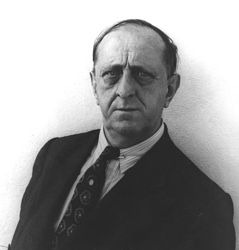
1877 – Marsden Hartley (d.1943) was an American Modernist painter, poet, and essayist. Hartley was born in Lewiston, Maine, where his English parents had settled.
In 1898, at age 22, Hartley moved to New York City to study painting at the New York School of Art. Hartley was a great admirer of Albert Pinkham Ryder and visited his studio in Greenwich Village as often as possible. His friendship with Ryder inspired Hartley to view art as a spiritual quest.
Hartley first traveled to Europe in April 1912, and he became acquainted with Gertude Stein's circle of avante-garde writers and artists in Paris. Stein, along with Hart Crane and Sherwood Anderson, encouraged Hartley to write as well as paint.

Finnish-Yankee sauna
In 1913, Hartley moved to Berlin, where he continued to paint. Many of Hartley's Berlin paintings were further inspired by the German military pageantry then on display, though his view of this subject changed after the outbreak of World War I, once war was no longer "a romantic but a real reality." The earliest of his Berlin paintings were shown in the landmark 1913 Armory Show in New York.
In Berlin, Hartley developed a close relationship with a Prussian lieutenant, Karl von Freyburg, who was the cousin of Hartley's friend Arnold Ronnebeck. References to Freyburg were a recurring motif in Hartley's work, most notably in Portrait of a German Officer (1914). Freyburg's subsequent death during the war hit Hartley hard, and he afterward idealized their relationship. Many scholars believe Hartley to have been gay, and have interpreted his work regarding Freyburg as embodying his homosexual feelings for him.
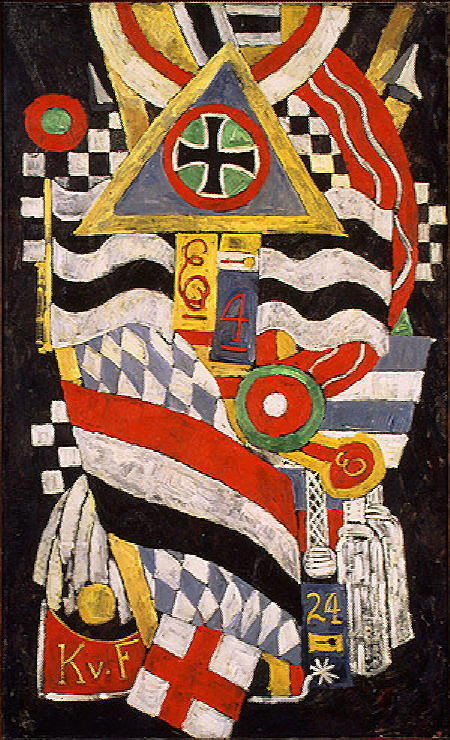
In addition to being considered one of the foremost American painters of the first half of the 20th century, Hartley also wrote poems, essays, and stories.
Cleophas and His Own: A North Atlantic Tragedy is a story based on two periods he spent in 1935 and 1936 with the Mason family in the Lunenburg County, Nova Scotia, fishing community of East Point Island. Hartley, then in his late 50s, found there both an innocent, unrestrained love and the sense of family he had been seeking since his unhappy childhood in Maine. The impact of this experience lasted until his death in 1943 and helped widen the scope of his mature works, which included numerous portrayals of the Masons.
He wrote of the Masons, "Five magnificent chapters out of an amazing, human book, these beautiful human beings, loving, tender, strong, courageous, dutiful, kind, so like the salt of the sea, the grit of the earth, the sheer face of the cliff." In Cleophas and His Own, written in Nova Scotia in the fall of 1936, Hartley expresses his immense grief at the tragic drowning of the Mason sons. The independent filmmaker Michael Maglaras has created a feature film Cleophas and His Own, released in 2005, which uses a personal testament by Hartley as its screenplay.

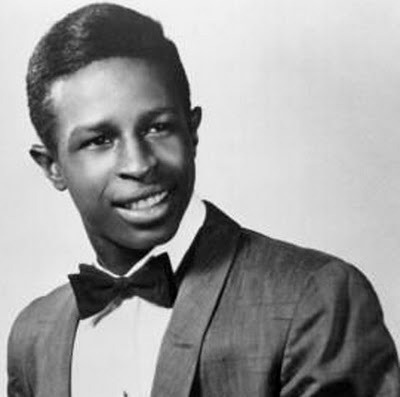
1946 – Arthur Conley aka Lee Roberts (d.2003) was a U.S. soul singer, best known for the 1967 hit "Sweet Soul Music".
Conley was born in McIntosh County, Georgia, U.S., and grew up in Atlanta. He first recorded in 1959 as the lead singer of Arthur & the Corvets. With this group, he released three singles in 1963 and 1964 – "Poor Girl", "I Believe", and "Flossie Mae" – on the Atlanta based record label, National Recording Company.
In 1964, he moved to a new label (Baltimore's Ru-Jac Records) and released "I'm a Lonely Stranger". When Otis Redding heard this, he asked Conley to record a new version, which was released on Redding's own fledgling label Jotis Records, as only its second release. Conley met Redding in 1967. Together they rewrote the Sam Cooke song "Yeah Man" into "Sweet Soul Music", which, at Redding's insistence, was released on the Atco-distributed label Fame Records, and was recorded at FAME studios in Muscle Shoals, Alabama. It proved to be a massive hit, going to the number two position on the U.S. charts and the Top Ten across much of Europe. "Sweet Soul Music" sold over one million copies, and was awarded a gold disc.
After several years of hits singles in the early 1970s, he relocated to England in 1975, and spent several years in Belgium, settling in Amsterdam (Netherlands) in spring 1977. At the beginning of 1980 he had some major performances as Lee Roberts and the Sweaters in the Ganzenhoef, Paradiso, De Melkweg and the Concertgebouw, and was highly successful. At the end of 1980 he moved to the Dutch village of Ruurlo, legally changing his name to Lee Roberts — his middle name and his mother's maiden name. He promoted new music via his Art-Con Productions company. Amongst the bands he promoted was the heavy metal band Shockwave from The Hague. A live performance on January 8, 1980, featuring Lee Roberts & the Sweaters, was released as an album entitled Soulin' in 1988.
Conley was gay, and several music writers have said that his homosexuality was a bar to greater success in the United States and one of the reasons behind his move to Europe and his eventual name change. In 2014, rock historian Ed Ward wrote, "[Conley] headed to Amsterdam and changed his name to Lee Roberts. Nobody knew 'Lee Roberts,' and at last Conley was able to live in peace with a secret he had hidden – or thought he had – for his entire career: he was gay. But nobody in Holland cared."
Conley died from intestinal cancer in Ruurlo, Netherlands aged 57 in November 2003. He was buried in Vorden.

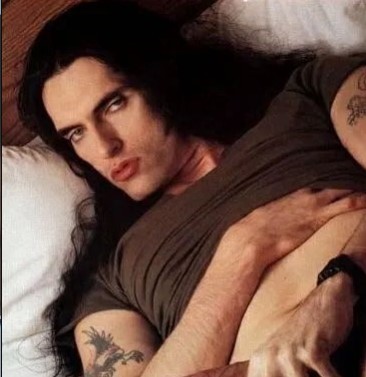
1962 – Peter Steele , formerly Lord Petrus Steele , actually Petrus Thomas Ratajczyk , born in Brooklyn , New York, was an American musician . Steele was the singer , bassist and songwriter for the metal bands Carnivore and Type O Negative.
Known above all for his powerful bass-baritone voice, Steele first worked as a singer and bassist with the heavy metal group Fallout and then with the thrash metal band Carnivore. After Carnivore had disbanded for the time being, Steele, who was still working for the New York Park Authority at the time, founded the music group Type O Negative together with Sal Abruscato, Kenny Hickey and Josh Silver. Steele was particularly controversial in the early years of the band due to supposedly right-wing extremist ideas in the public. He himself always denied such allegations. He later created the Vinland flag , inspired by the Nordic flags and his own Scandinavian ancestors , which was henceforth to be found on the band's releases.
In August 1995, Steele, who was an imposing figure with his stature and height of 2.03 m, posed naked for the US edition of Playgirl. However, when he learned that around 75% of the readership are homosexual men, some of whom would now make advances to him and he was then exposed to the malice of the other band members and fans, he wrote the song I Like Goils (dt. I like girls ).
Peter Steele died on April 14, 2010 of complications from an aortic aneurysm . Steele's companion Sal Abruscato (formerly Type O Negative drummer) said they were in the process of getting Steele into an ambulance when he passed away before leaving the house. Before his death, Steele had been drug free for nine months and was in the process of making plans for a new Type O Negative album.


1969 – Richard Hake (d.2020) was a journalist and reporter for WNYC, where he was one of the hosts of the weekly morning program, Morning Edition.
Richard Scott Hake was born in the Bronx to Richard James Hake, a New York City police detective, and Joy Mekland, a clerical worker and secretary. He graduated from Carmel High School in 1987, then from Fordham University in 1991, and began working at NPR in 1991 while still at Fordham. He became a news host and reporter at WNYC in 1992. He was openly gay.
He spent 28 years working as a radio news host, reporter, and producer. He featured on several local and national NPR programs, such as Morning Edition (which he hosted), Weekend Edition, All Things Considered, and On the Media. He also broadcast on MTV, the BBC, WCBS, WBGO, WOR, and WFUV radio. Hake hosted for MTV's Logo Network's The Advocate News magazine program. His documentary work includes "The Perfume of the Bronx" and the "Coney Island Cyclone Anniversary."
For his reporting, Hake was awarded accolades from the Associated Press Broadcasters Association and the Society of Professional Journalists. Hake made his Broadway debut as a chimney sweep in Mary Poppins.
In his Twitter profile, Hake noted his unique role in the bustling Big Apple, writing: "I wake people up and tell them stories on the alarm clock, the app, streaming, in the shower, in the car, etc."
As coronavirus cases surged in the city and officials told office workers to stay home, Hake set up a makeshift studio in his one-bedroom apartment, complete with an art deco "on air" light and various microphone flags bearing the station's logos over the years.
Hake died on April 24, 2020, at age 51, in his Upper East Side home. His manner of death was ruled to be a result of an accident, according to the City's Medical Examiner.


1970 – Christopher Klucsarits, better known as Chris Kanyon (d.2010), US Professional wrestler, best known for his work in World Championship Wrestling and the World Wrestling Federation, under the ring names Kanyon and Mortis.
In 2006, after Kanyon's release from WWE, he began a gimmick in which he was an openly homosexual pro wrestler. This included a publicity stunt wherein he stated that WWE released him from his contract because of his sexuality. Kanyon later told reporters and even stated on a number of radio interviews, that this was just a publicity stunt and he was heterosexual. However, he later retracted these statements and acknowledged that he was in fact homosexual.
Before his death Kanyon was working on a book, Wrestling Reality, with Ryan Clark. The book was released November 1, 2011, and it features Kanyon's struggles as a closeted gay man as a prominent theme.

1984 – Illinois repeals its "lewd fondling or caress" law, more than two decades after repealing its sodomy law.


12 notes
·
View notes
Text
Oz Rock bands were big in Brazil in the 1990s. Australian surfers know its breaks. [...] [I]n the past decade [2005-2015] Brazil has had the second fastest rate of migration to Australia [...].
Australia’s connection with Brazil began in 1787 with the First Fleet voyage. This was thanks to the port of Rio’s location in the South Atlantic and a centuries-long British-Portuguese alliance – unique among European powers in the Age of Empires. The First Fleet had three layovers on its relatively cautious eight month voyage from Britain: a week in the Spanish colony of Tenerife in the Canary Islands, a month at Rio in the Portuguese colony of Brazil and a month at the Dutch East India Company’s Cape colony in South Africa. Fleet commander Arthur Phillip had not intended to rest and resupply at Rio but sailing conditions made it prudent to do so. And Phillip’s former service in the Portuguese navy ensured a cordial welcome from Rio’s colonial authorities.
At this time, as Bruno Carvalho writes in Porous City: A Cultural History of Rio de Janeiro (2013), Rio enjoyed rising status within the Portuguese Empire. In 1763 it had been named the new capital of Brazil. In 1808 Portuguese royals fled to Rio to escape Napoleon and remained there at the end of the Napoleonic Wars in 1815. As a consequence, Rio could boast of being the only American city to serve as a centre of European power.
One First Fleet official lamented how little the British knew of Rio. This came to be addressed, as Luciana Martins notes in A Bay to be Dreamed Of: British Visions of Rio de Janeiro (2006), as increasing numbers of British visitors ventured there during the 19th century. Visitors included New South Wales Governor Lachlan Macquarie, and later Charles Darwin – along with thousands of convict and free migrants on board ships calling at the port of Rio.
Writing in Connected Worlds: History in Transnational Perspective (2005), Emma Christopher observed that in Australian history books, travel from Britain to Australia seemed to have been “covered as if in the blink of an eye”.
This inspired her to write of the “watery non-places” of the journey not as voids, but rather as places where much transnational history was lived [...].
[J]ournals by intending Australian colonists such as Macquarie’s wife Elizabeth allow glimpses of colonial Rio through colonial Australian eyes. Elizabeth Macquarie assessed Rio with keen intelligence and, more challengingly – as Jane McDermid has argued in recent research on histories of the British abroad – a callously casual racism.
First Fleet journals tell us that, in 1787, convicts confined to ship at Rio witnessed enslaved West Africans rowing Portuguese fruit sellers around the anchored Fleet transports in decoratively festooned boats.
Convicts overheard and exchanged stories from officials permitted shore leave: stories of the songs of captive West Africans awaiting sale at the port marketplace; of colourful Portuguese Catholic institutions and festivities that were exotic to straight-laced British Protestants. Stories of being forbidden, on pain of death, to venture to hinterland jewel mines. Onshore at Rio, colonial migrants bound for Australia befriended Portuguese colonists, despite the language barrier. They purchased curios. They passed judgement – glowing and harsh – on the people of the Portuguese colony, its natural and built environment, just as Brazilians in turn scrutinised them.
---
Text by: Julie McIntyre. “I Go to Rio: Australia’s forgotten history with Brazil.” The Conversation. 16 September 2015. [Bold emphasis and some paragraph breaks/contractions added by me.]
23 notes
·
View notes
Text
I’ve been reading through Stoker’s working notes for Dracula for a project and I haven’t 100% finished yet (I’ve only gotten through his handwritten plot notes) but here are a few interesting things I’ve read so far:
- Dracula’s castle was originally in Styria rather than Transylvania, which makes me think Stoker was inspired by Carmilla.
-In Stoker’s original vampire rules, he states that “painters cannot paint him—their likenesses always like some one else” and that “could not photograph—come out like corpse or black”- rules which never show up in the book! He had considered adding a painter character called Francis Aytown so perhaps these rules would have been included through the Count’s interactions with this character???
-Mina and Lucy originally had an old schoolfellow called Kate Reed! I kind of wish she was still included because I would’ve loved for Mina and Lucy to have a girl squad. I’m tempted to do my own design for her (I’d probably make her a painter or photographer then??)
- Quincey was originally called BRUTUS M MARIX????
- Originally, Dr Seward was Lucy’s fiancé. Arthur was a much later addition to the novel.
-The train times in the novel are actually accurate- Stoker made extensive notes on train schedules which is so Mina Harker “train fiend” core of him.
-The original title for the novel was “The Un-dead”
-In the excised second chapter of the novel, Jonathan Harker encounters a female vampire in Munich called Countess Dolingen (who is suspiciously similar to Carmilla- she’s a Countess from Styria, whose body is interned in an abandoned village). He’s saved from her by a wolf who is presumably either Dracula or a wolf sent by Dracula to keep Jonathan safe (for now). The chapter was later published posthumously as a short story in 1914 under the title ‘Dracula’s Guest’ by Stoker’s widow, Florence Anne Lemon Balcombe (yes I’m including her full name because Lemon is such an adorable middle name). The story is actually great, I’d seriously recommend checking it out. Though, despite the notes making it clear the narrator is supposed to be Jonathan Harker, he feels like a different character.
-A few days after this event, Jonathan goes to see the Flying Dutchman at the opera ??? Idk Jonathan’s adventures in Munich could be a book unto themself lol
-Another excised event from Munich is Jonathan visiting the “Munich Dead House” and seeing a dead man whose face he later sees on the Count ??? In the facsimile I’m reading, Eighteen-Bisang and Miller explain this with an excerpt from The Atlantic Monthly from 1877: “There is a curious burial custom at Munich. The law requires that every man, woman, and child who dies within city limits shall lie in state for three days in the Leichenhaus (dead house) of the Gottesacker, the southern cemetery, outside the Sendling Gate. This is to prevent any chance of premature burial, an instance of which many years ago gave rise to the present provision.“ If a person had in fact been sent there who was still alive, there was a bell attached to a string they could pull.
-The three female vamps in Dracula’s castle were originally killed by being OBLITERATED BY LIGHTNING
-The last chapter was potentially going to include a werewolf- “a Tourist’s Tale—one killed by wolf (wehr?)”
Source: Bram Stoker’s Notes for Dracula: A Facsimile Edition, Annotated and Transcribed by Robert Eighteen-Bisang and Elizabeth Miller
#I typed this all up and then tumblr made the note disappear for some reason so I had to retype it oof#anyway I hope ppl find this as interesting as I did!!#dracula#dracula's guest#long post#text post
29 notes
·
View notes
Note
⌨ + the fic of your choice! 💜
Arthur Rokesby wasn’t quite sure how he ended up on a ship bound for America. He was certain that it had something to do with imbibing far too much alcohol and the fact that his best friend, Edmund Bridgerton had decided to settle down. The headache and throbbing head explained the first part and his wounded heart explained the second.
He was happy for Edmund. Truly, he was. Violet Ledger was the perfect choice for him. She was beautiful, intelligent, and made Edmund very happy. Theirs was a match made for love, which wasn’t always common in polite society. Arthur had always thought that he and Edmund would sow their wild oats for nearly a decade before settling down. But this wasn’t to be. His best friend was married and he was not.
All his older siblings had married for love thus far and his twin was intent on practicing medicine. This left Arthur quite alone in the world and somehow on a ship bound for York City. If he had stayed home any longer, his mother would likely work on finding him a match. She was quite well-known for her matchmaking attempts. And he had no desire to settle down yet. So an adventure it was.
How long would he stay there? No idea. What was he going to do? Again, no idea. He couldn’t even remember his thought process that led him to board the ship in the first place. But there wasn’t much he could do about the situation in the middle of the Atlantic Ocean, was there? His only choice was to embrace it, which Arthur did so willingly.
His brother Edward’s stories of America from his time in the war had always intrigued him. It had been a dream of his to set sail for America. Although Edmund or one of his brothers was always included in this daydream, it appeared it was a dream he would embark on alone. He would probably never hear the end of it from his mother once he sent word of his adventure. She was likely worried sick over his sudden disappearance. His only hope was that perhaps his mother had imbibed too much at the wedding as well and hadn’t yet noticed his absence.

Send me ⌨ + title to one of my fics and I’ll write a sentence for that fic!
#oc: arthur rokesby#fic: stealing her patriot heart#fd: bridgerton prequel#fd: the rokesbys#heather💜
5 notes
·
View notes
Text


YOU SHOULDN’T TRUST ME. YOU SHOULDN’T. I’M NOT A GOOD PERSON. I’M NOT ME WHEN I AM HERE.
independent, private & selective arthur hartman of the atlantic city story. written by jasmine. (she/her. 18+. est.) iconless. prefers to plot. ©
#i just noticed your hands — self promo#the atlantic city story rp#indie rp#independent rp#indie roleplay#independent roleplay
2 notes
·
View notes
Text
Two Norma Shearer Silent Films

Norma Shearer meets Norma Shearer in Lady of the Night

Norma Shearer and Johnny Mack Brown in A Lady of Chance
Lady of the Night (Monta Bell, 1925)
Cast: Norma Shearer, Malcolm McGregor, Dale Fuller, George K. Arthur, Fred Esmelton, Lew Harvey. Screenplay: Alice D.G. Miller, based on a story by Adela Rogers St. Johns. Cinematography: André Barlatier. Art direction: Cedric Gibbons. Film editing: Ralph Dawson.
A Lady of Chance (Robert Z. Leonard, 1928)
Cast: Norma Shearer, Johnny Mack Brown, Lowell Sherman, Gwen Lee, Eugenie Besserer. Screenplay: Edmund Goulding, Andrew Percival Younger; titles: Ralph Spence, based on a story by Leroy Scott. Cinematography: J. Peverell Marley, William H. Daniels. Art direction: Cedric Gibbons. Film editing: Margaret Booth.
Norma Shearer often seemed to love the camera more than her leading men. Granted that neither Malcolm McGregor (Lady of the Night) nor Johnny Mack Brown (A Lady of Chance) is much more than a handsome presence on the screen -- not quite enough to act with when you've got Shearer's talent -- she still seems to hog these two silent pictures, especially when she's playing a tough girl. In Night she has a double role: the hard-bitten Molly Helmer and the sweet rich girl Florence Banning. She's surprisingly good as Molly -- and totally unbelievable as Florence, who decides to sacrifice her chance at marriage with inventor David Page (McGregor) because Molly had him first. But the unbelievability is built into the story by Adela Rogers St. Johns, who churned out this sort of stuff for movies on a regular basis. In A Lady of Chance, Shearer has a role that would later be perfected by Barbara Stanwyck: the tough grifter with a soft heart. The story is nonsense again: She falls for her mark, a Southerner she thinks is a rich man, even after he takes her home to Alabama and she learns that she has jumped to the wrong conclusion. Stanwyck does it better in Ball of Fire (Howard Hawks, 1941) and The Lady Eve (Preston Sturges, 1941), but Stanwyck also had better directors than the prolific but undistinguished Robert Z. Leonard. He allows, or perhaps encourages, Shearer to mug and pose endlessly; at first she's delightful, but a little of that sort of thing goes a long way. A Lady of Chance also contains an embarrassing heap of period racism, when Shearer and Brown are being wheeled along the Atlantic City boardwalk by a singing black man, and Brown remarks that it reminds him of "the darkies singing on the plantation back home."
3 notes
·
View notes
Text
TOP O’ TH’ WORLD
1907 - 1908
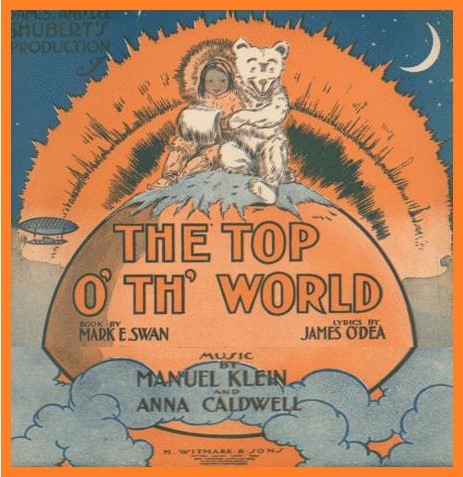
Top O’ Th’ World is a musical by Mark E. Swan with music by Manuel Klein and Anna Caldwell and lyrics by James O’Dea, featuring songs with lyrics by Joseph W. Herbert. It was originally produced by J.M. Allison, staged by Frank Smithson, and choreographed by William Rock and Signor Luigi Albertieri.
The story concerns Maida, a little girl who finds herself mysteriously transplanted to the workshop of Kris Kringle near the city of Illusia. There is a love story in which a near discoverer of the North Pole resolves to find it, if only to rescue a maiden who has been frozen by Jack Frost at the command of Aurora Borealis, Queen of the Northern Lights. Guided by Kankakee, an Eskimo, and his little daughter Kokomo, the entire party proceeds to Illusia, accompanied by The Candy Kid and The Jack in the Box, who were brought to life in Kris Kringle’s workshop, and who are paired up as travelling companions of the Friendly Bear.

The show was designed to appeal to both young people and their parents. The variety musical included:
The Collie Dog Ballet - “8 captivating, whirling misses and almost-human dancing dogs.”
The Candy Kid
The Intelligent Bear ~ Kathleen Clifford and Arthur Hill as ‘Maida and the Friendly Bear’
Jack Frost
The Heart of Fairyland
In the Land of Christmas
The Top of the World - Santa’s Workshop
The Spring Time of Love
"By the sun that burns throughout the day and the moon that shines at night by the great caciques of the past and the present, by the rivers that flow through northern forests, and the rivers where the hunted deer doth quench his thirst, by all the brave and the true in Eskimo history, I bid you welcome this day in the beautiful month of the seasons to witness little Kokomo." ~ KOKOMO the ESKIMO (Anna Laughlin)

The musical opened in Toronto at the New Alexandria Theatre on August 26, 1907. It then moved to Buffalo NY, Rochester NY, Detroit MI, Cincinnati OH,

On October 16, 1907, Top O’ Th’ World played Young’s Pier in Atlantic City. [Although this newspaper suggests the play tried out at Young’s Pier in Atlantic City, the newspapers there do not list any such performance on these dates.]

Top O’ Th’ World opened on Broadway on October 19, 1907 at the Majestic Theatre (5 Columbus Circle at 59th Street). The Majestic had previously housed the family-friendly hits The Wizard of Oz and Babes in Toyland. Anna Loughlin, who plays Kokomo the Eskimo Princess in The Top O’ Th’ World, returned to the Majestic where she had played Dorothy in The Wizard of Oz. Arthur Hill (the Bear) was her Cowardly Lion.

About the Venue: The Majestic was built in 1903, one of the first theatres by Columbus Circle, which was expected to become another theatre district. It went through many name changes and owners until 1923, when William Randolph Hearst took over, changed the policy to cinema, and renamed it the Cosmopolitan. It was torn down in 1954 to allow for wider sidewalks in front of the New York Coliseum.
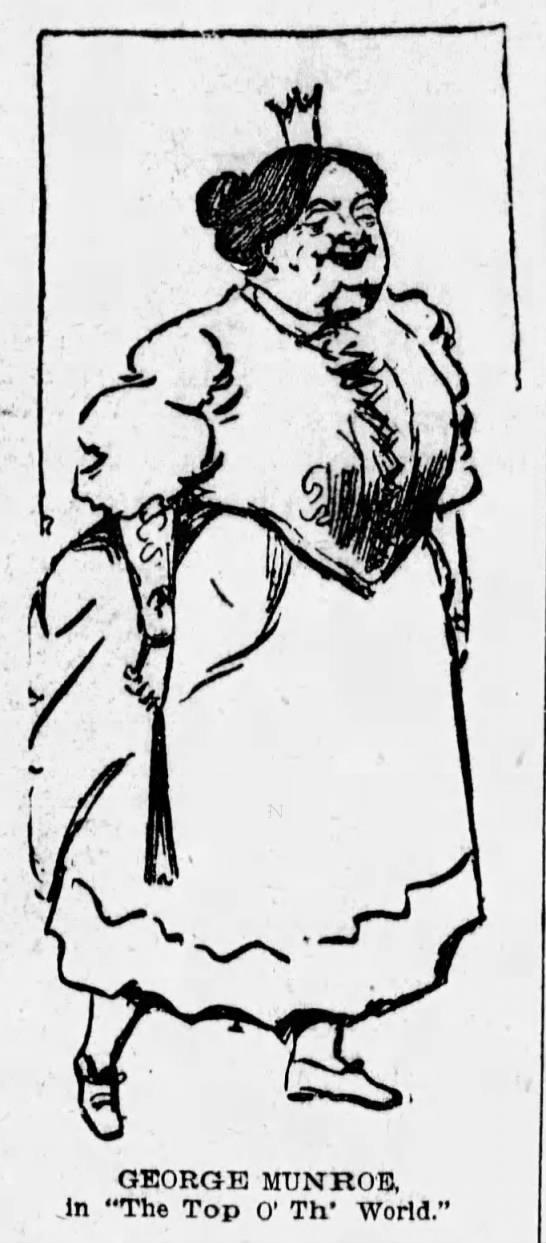
George Munroe cross-dressed to played the role of Aurora Borealis, Queen of the Northern Lights, in the style of a pantomime dame.
On February 3, 1908, the show moved to the Casino Theatre (1404 Broadway at 39th Street) where it closed on February 22, 1908 after 156 performances.
“’The Top O’ Th’ World’ is a bit of stage-jelly with powdered sugar spiced mildly with peppermint and wintergreen.” ~ INTERNATIONAL PRESS ASSOCIATION
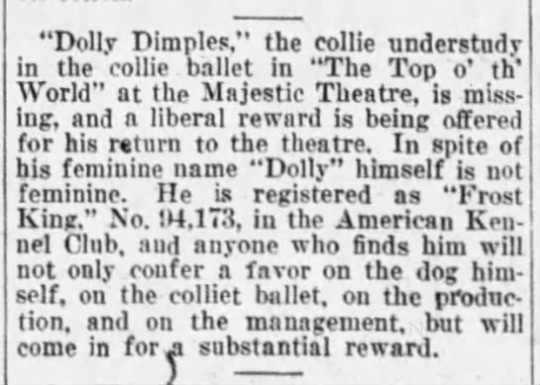
Frost King (aka Dolly Dimples) is at large in the big city!
The first week in December, a new song titled “Dinah” was added to the show. It was also announced that the production had arranged ‘closed automobiles’ to transport groups of 25 children or more to the theatre for free. To accommodate holiday audiences, the production offered daily matinees.

“On Christmas Day a Santa Claus will distribute dolls to the little girls of the audience who are so fortunate as to draw tickets for them. Two dolls, of life size, are among the prizes in this ingenious lottery - these being described as ‘made in France, of the finest material and dressed for the occasion’."
The doll promotion was so successful it was continued at all Wednesday matinees.
~ Fun and Feast for ‘Top o’ th’ World’ ~
“After last night's performance of ‘The Top o' th' World’ at the Majestic Theatre there was yet another performance for the benefit of the company only. A small stage had been built under the regular stage, and on this various members of the company made fun for the rest. Sam Diamond indulged in recitations from Shakespeare and George W. Monroe and Catherine Clifford were also on the program. Then Manager J.M. Allison and his wife treated the entire organization to a beefsteak dinner. Congressman and Mrs. James W. Rhlnock of Ohio Joined In the festivities” ~ January 1, 1908

About the Venue: The Casino Theatre was built in 1882 for light musicals and operetta, but showed mostly vaudeville starting in 1892. A 1905 fire necessitated much reconstruction. In February of 1930, the theatre was demolished to make room for the expanding garment district.

In an attempt to keep the show fresh producers staged a song contest. There were no winners except the show, which got free publicity from the stunt.
After closing at the Casino on February 22nd, The Top o' th' World went on the road, opening with Philadelphia on February 24th, then visiting Baltimore, Washington, Boston, and stopping in Atlantic City.

Top O’ Th’ World opened in Atlantic City at the Apollo Theatre on the Boardwalk on April 16, 1908. The theatre was supposed to host Miss Marlowe during this time, but her engagement was canceled.
In 1910, the play morphed into The Top O’ Th’ World Dancers, extracting the more popular acts (including the Collie Ballet) into a variety / vaudeville production.
#Top O' Th' World#Collie Ballet#Theatre#Musical#Broadway#Atlantic City#Apollo Theatre#Broadway Musical#Santa Claus#1908
2 notes
·
View notes
Text
Early Television History - Broadcasts And Events.
1930:
July 14 – For the first time in the United Kingdom, a television drama is broadcast. The drama is a production of Luigi Pirandello's The Man With the Flower in His Mouth; it is broadcast by the BBC from Baird's studios at 133 Long Acre, London.
November 5 – Baird television transmissions at Hairdressing Fair of Fashion include the world's first television commercial for the Eugène Method of permanent hair waving.
December 7 – W1XAV in Boston, Massachusetts broadcasts the first television commercial in the United States, of I.J Fox Furriers during The Fox Trappers.
1934:
July 11 - In the U.S., the Communications Act of 1934 stipulates that commercial television stations "operate in the public interest, convenience, and necessity". The Federal Communications Commission (FCC) is charged with the responsibility of enforcing the act.
1937:
January 19 – BBC Television broadcasts The Underground Murder Mystery by J. Bissell Thomas from its London station, the first play written for television.
May – Gilbert Seldes becomes the first television critic, with his Atlantic Monthly magazine article, the "Errors of Television".
May 14 – The BBC broadcasts a thirty-minute excerpt of Twelfth Night, the first known instance of a Shakespeare play televised. Among the cast are Peggy Ashcroft and Greer Garson.
November 11 (Armistice Day) – BBC Television devotes the evening to a broadcast of Journey's End by R. C. Sherriff (1928, set on the Western Front (World War I) in 1918), the first full-length television adaptation of a stage play. Reginald Tate plays the lead, Stanhope, a rôle he has performed extensively in the theatre.
November 27 – NBC in the United States broadcasts the first of six live teleplays of The Three Garridebs (based closely on Arthur Conan Doyle's story "The Adventure of the Three Garridebs"), the first known television pilot, in which Louis Hector becomes the first actor to play Sherlock Holmes on television.
1938:
February 11 – BBC Television in England broadcasts the first ever television science-fiction, a 35-minute adaptation of a segment of the play R.U.R. by the Czech playwright Karel Čapek.
May 14 – The first quiz show, Spelling Bee, is televised by the BBC.
June 7 – An excerpt from Susan and God is the first Broadway play with its original cast to be broadcast on television. Station W2XBS uses exact replicas of the stage sets, with Nancy Coleman, Gertrude Lawrence and Paul McGrath appearing on the broadcast.
November – Due to freak atmospheric conditions, a BBC TV broadcast from London is received in New York City. A film camera was used to record the silent images which included the performance of a play, a cartoon, and other matter. A four-minute excerpt from this filmed recording survives and is, as of 2014, considered the only surviving example of a pre-war BBC television transmission.
November 12 - NBC's W2XBS broadcasts what is the first telecast of an unscheduled event, a fire on Wards Island near Manhattan.
1939:
March 4 – The BBC Television Service broadcasts one of the first television plays specially written for the medium, Condemned To Be Shot by R. E. J. Brooke, live from its London studios at Alexandra Palace. The production is notable for the use of a camera as the first-person perspective of the play's unseen main character.
March 27 – The BBC broadcasts the entirety of Magyar Melody live from His Majesty's Theatre in London. The 175-minute broadcast is the first showing of a full-length musical by television.
April 30 – Franklin D. Roosevelt, appearing at the opening ceremony of the 1939 New York World's Fair, becomes the first President of the United States to give a speech that is broadcast by television.
May 3 – The Walt Disney cartoon Donald's Cousin Gus airs on NBC's experimental station W2XBS (later WNBC-TV) in New York. This marks the first movie cartoon to be televised in the United States.
November 23 – The earliest known live telecast of the Macy's Thanksgiving Day Parade is broadcast locally in New York.
0 notes
Text


→ “It was such a labour of love”: Jessica Hecht on The Atlantic City Story
“Mike Faist is so compelling as an actor. He’s extremely open and very meticulous in his work. But also, even when you’re watching him in a big Broadway stage, he’s so truthful and there’s something very gentle about his performance style. He’s just very delicate in what he does. I was blown away by him. There was a lot of dialogue and we would play with it in different iterations, and he was so available! I actually probably have never worked with another co-star who was quite as available and quite as easy on film. He was just magnificent.”
#mike faist#jessica hecht#atlantic city story#connor murphy#dear evan hansen#deh#jack twist#brokeback mountain#brokeback mountain west end#arthur atlantic city story#riff#riff lorton#west side story#west side story 2021#susan bunch#friends#jane atlantic city story#broadway#what's holy 2 queue
121 notes
·
View notes
Text
does arthur miller exist as a person. bc if not that’s going to be my next muse.
everyone say thank you to the atlantic city story
0 notes
Text



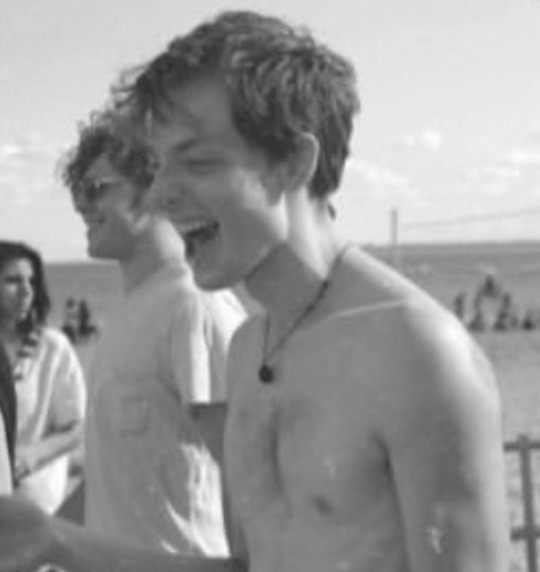
The necklace.
#mike faist#west side story 2021#riff west side story#connor murphy#morris delancey#dear even hanson#newsies#panic amazon#dodge mason#the atlantic city story#arthur#necklace
75 notes
·
View notes
Text
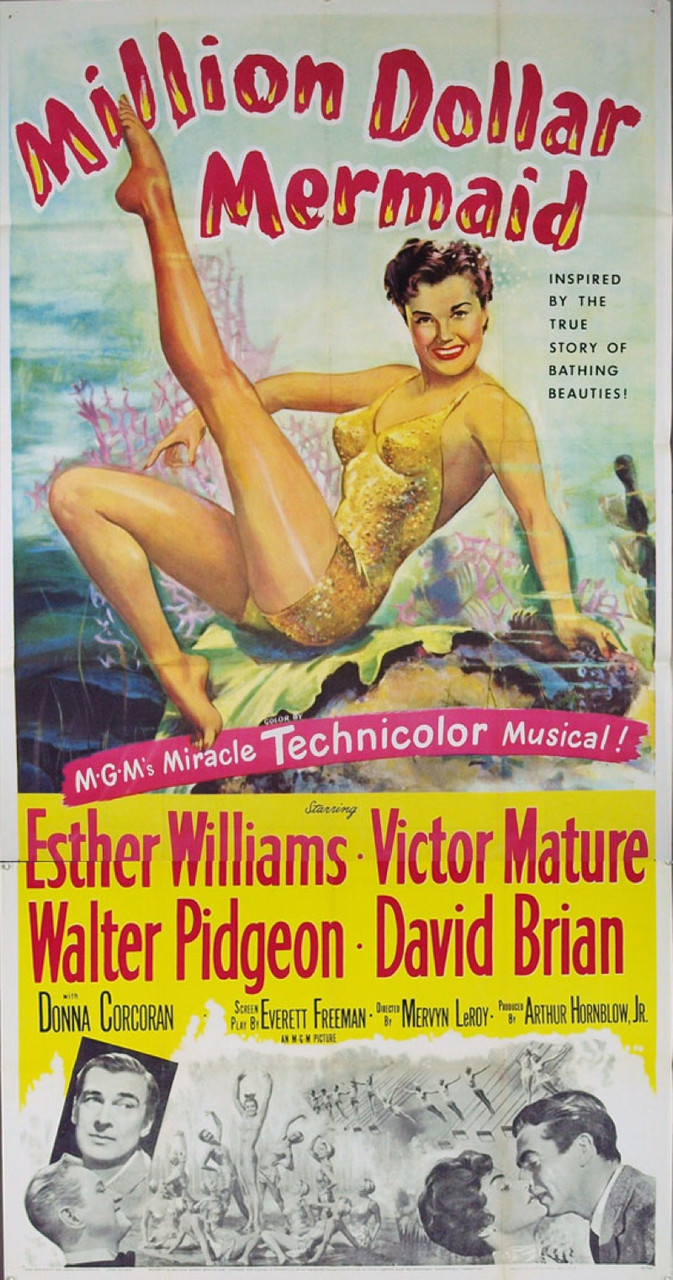
Day 82- Film: Million Dollar Mermaid
Release date: December 4th, 1952.
Studio: MGM
Genre: Musical
Director: Mervyn LeRoy
Producer: Arthur Hornblow Jr
Actors: Esther Williams, Victor Mature, Walter Pidgeon
Plot Summary: This is a biography of famous swimmer and performer Annette Kellerman, also remembered as the originator of the one-piece bathing suit for women. We follow her and her father as they travel around the world for Annette to race and perform in carnival shows, working her way up to the famous Hippodrome in New York City.
My Rating (out of five stars): *** ½
Like Esther Williams’ other film in 1952, Skirts Ahoy!, this was pretty uneven in terms of quality, but it was always enjoyable. It wasn’t filled with as much silly fun as Skirt’s Ahoy!, but it had several jaw-dropping musical swimming numbers. The biography aspect of this pioneering woman was great as well. If you like Esther Williams, you’ll like this movie, even if it’s not a masterpiece.
The Good:
The musical swimming numbers! Everything about them was lavish, gorgeous, and a splendor for the eyes. The costumes, the color, the staging, the framing, etc... I want to go back and rewatch them. They are so unique- where else in Hollywood could you find musicals with swimming and diving?
The Technicolor. I’m going to run out of adjectives because gorgeous, vivid, luscious, and rich are all words I use over and over.
Esther Williams. She’s not an amazing actress, but she has such warmth and charisma about her, and she’s so beautiful it makes you weak in the knees. I still love the fact that she has more of an athlete's body than a typical Hollywood bombshell’s. Her shoulders are broader, her waist is thicker, her thighs are bigger and stronger... all of which made me swoon even more. I love her speaking voice as well- it's so soothing.
Walter Pidgeon as Annette’s father. He was just the kind of father you’d hope for, and Pidgeon had the usual appealing power of his presence as an actor.
Learning the biography of Annette Kellerman. She seems like a pretty cool boundary pusher in the early 20th century. She got a lot of attention for wearing a one-piece bathing suit, rather than the skirts and pantaloons women of the time wore. There is no way a swimmer could be competitive in swimwear like that!
The historical aspects, especially with how female athletes were viewed and treated.
The Bad:
I didn’t really like Victor Mature or his character. He is portrayed as a total huckster, and I just didn’t find it appealing at all. I hope Kellerman’s husband in real life wasn’t like that.
I didn’t like the other guy in the love triangle either. He was kind of boring and not very attractive. Why can’t they find some good men for Esther?! She deserves better!
Sometimes there was too much drama and not enough fun. Williams is not an especially great dramatic actress (no matter how much I love her!), so I prefer her in more light-hearted stuff. I thought she was perfect in Skirts Ahoy!, for example.
I wish the musical numbers were more spread out. I understand why we didn’t really get musical numbers until Kellerman started performing at the Hippodrome, because it fit with the story, but I wished we could have had one of the numbers earlier.
I gripe a lot about accents, so I cannot, in all fairness, neglect to mention that Kellerman and her father were Australian, yet she had an American accent, and her father had a Mid-Atlantic accent. I didn’t really mind it, though, because I think it would have been distracting if Williams tried to do an Aussie accent!
0 notes
Text
Elwood City Limits Episode 186: Every Morning, I Turn Into A Gorilla
This is it. After so many years, the guys get their first real taste of the Flash Animation years of Arthur with the Season 16 premiere, "Based on a True Story." Will recaps the many behind-the-scenes changes in Arthur that led up to this, and he and Lucas give their honest opinions on both the new look of the show and the new characters in the Arthur universe. Along the way, an Arthur staple makes a welcome return, the Atlantic Canada connections to Arthur are found out, and the animal hierarchy is re-litigated. It's a whole new era, so come along with us!
Elwood City Limits new episode is LIVE!
1 note
·
View note